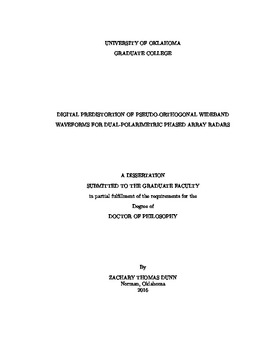| dc.contributor.advisor | Yeary, Mark | |
| dc.contributor.author | Dunn, Zachary | |
| dc.date.accessioned | 2016-05-09T16:33:18Z | |
| dc.date.available | 2016-05-09T16:33:18Z | |
| dc.date.issued | 2016-05 | |
| dc.identifier.uri | https://hdl.handle.net/11244/34587 | |
| dc.description.abstract | Many new and interesting radar operational modes and techniques are being explored to maximize the efficiency and utility of next-generation radar systems while complying with increasingly stringent operational and budgeting requirements. This dissertation's aim is to analyze and present possible techniques to help maximize the scientific value of measurements while complying with operational requirements through methods of physical transmission and exciting the target area, methods of processing the received waveforms, and methods of designing waveforms for a given system.
In regard to methods of physical transmission and exciting the target area, this dissertation addresses unique problems that will be faced by next-generation radar systems utilizing simultaneous transmit and simultaneous receive operational modes in polarimetric active phased array architectures. This is accomplished through establishing mathematical representations of the received complex baseband waveforms for dual-polarimetric radar operation and analyzing the predicted behavior versus traditional polarimetric radar alternating transmit and simultaneous receive operation.
In regard to methods of processing the received waveforms, pulse compression will undoubtedly be widely utilized in future radar systems due to the increase in range resolution that it provides for a given pulse length. Additionally, matched filtering allows the realization of simultaneously transmitted pseudo-orthogonal waveforms occupying the same spectral region that would be otherwise impossible. As a result, the mathematical basis of pulse compression is provided, and pulse compression effects are taken into account in all relevant system analyses in this manuscript.
This dissertation arguably provides the most attention in regard to methods for designing and modifying waveforms for application in a given system. An analysis of common pulse compression waveforms for suitability in pseudo-orthogonal waveform sets is provided in addition to a novel method for designing polyphase coded waveform and non-linear frequency modulated waveform based pseudo-orthogonal waveform sets utilizing particle swarm optimization. Additionally, for the first time, research is presented on the full design and application methods for digital predistortion of wideband solid state radar amplifiers. Digital predistortion methods and results are presented for both the impedance matched high power amplifier case and for the varying load impedance case that can be expected to be encountered in radar systems utilizing electronic beamsteering in active phased array architectures.
Overall, this dissertation's aim is to provide relevant results from conducted research in the form of analysis and novel design methods that can be applied in both the design and operation of next-generation radar systems to maximize utility and scientific data quality while operating within given system and environmental specifications. | en_US |
| dc.language | en_US | en_US |
| dc.subject | Digital Predistortion | en_US |
| dc.subject | Phased Array | en_US |
| dc.subject | Polarimetric | en_US |
| dc.subject | Engineering, Electronics and Electrical. | en_US |
| dc.title | Digital Predistortion of Pseudo-Orthogonal Wideband Waveforms for Dual-Polarimetric Phased Array Radars | en_US |
| dc.contributor.committeeMember | Fulton, Caleb | |
| dc.contributor.committeeMember | Goodman, Nathan | |
| dc.contributor.committeeMember | Ruyle, Jessica | |
| dc.contributor.committeeMember | Biggerstaff, Michael | |
| dc.date.manuscript | 2016-05 | |
| dc.thesis.degree | Ph.D. | en_US |
| ou.group | College of Engineering::School of Electrical and Computer Engineering | en_US |
